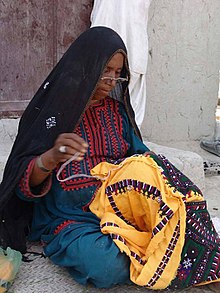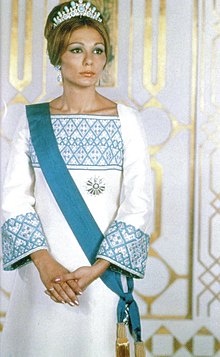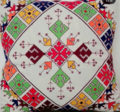Balochi needlework
 Balochi woman creating needlework in Iran | |
| Type | Handicraft |
|---|---|
Balochi needlework (also known as Balochi embroidery; Balochi: گُد دۏچی) is a type of Balochi handicraft made by the Baloch people.[1] It is considered a heritage art, has been recognized by UNESCO, and it sells internationally.[1][2] The Baloch people are native to the Balochistan region of South and Western Asia, encompassing the countries of Pakistan, Iran, and Afghanistan.


History
[edit]The Baloch people are from the Pakistani province of Balochistan; the Iranian province of Sistan and Baluchestan; and the southern areas of Afghanistan, including Nimruz, Helmand and Kandahar provinces.[3] The exact history of Balochi needlework is unknown. One theory is Balochi needlework originated from Mehrgarh (in modern-day Pakistan), a Neolithic site and culture.[4] Another theory is it was brought from the migration of the Slavs to Balochistan approximately 200 years before the founding of Islam,[5] their traditional embroidery is called Rushnyk and contains many similarities. Another theory is the craft had developed alongside the silk production industry.[6]
Different regions of Balochi tribes have their own distinct needlework designs.[7] This craft has traditionally been created only by women, and has been passed down through the generations.[5][8][7] The stitching designs and patterning hold meaning; common motifs include arrows, "chicken feet", diamonds, and flowers.[7] Some of the designs may also incorporate other materials such as small pieces of mirror (known as shisha), different colors of thread, and/or pieces of colored fabric.[9][1] The needlework was traditionally used for decorating women's clothing,[10] however it has also been used for decorating pillows, curtains, tablecloths, and men's clothing.[11]
In 2015, the majority of the sales of Balochi needlepoint clothing happened in Pakistan and Afghanistan.[11]
In fashion
[edit]In the 1960s, Mehr Monir Jahanbani, renowned for her discerning eye for traditional craftsmanship, discovered the intricate Baluchi needlework and immediately recognized its potential as a fashion statement. Collaborating with designer Keyvan Khosrovani, Jahanbani began incorporating this exquisite embroidery into contemporary designs, blending it seamlessly with modern aesthetics. Their collaborative efforts culminated in a series of stunning royal dresses for Empress Farah Pahlavi, where the Baluchi needlework became an iconic decorative element.[12] Notably, artisans like Mahtab Norouzi are believed to have contributed to the exquisite embroidery, further enhancing the cultural richness of these creations. Among these designs, a particularly famous dress inspired by a sunset featured a color gradient from black to red, yellow, sky blue, and silver, symbolizing the Empress’s deep appreciation for this traditional art form and its significance in Iranian culture.[13] One particular dress, designed by Mehr Monir Jahanbani and Keyvan Khosrovani, featured a gradient from a black background to shades of red, yellow, sky blue, and silver, inspired by a sunset.[13]
Notable Balochi needlework artisans include Mahtab Norouzi.[14] Farah Diba Pahlavi, the former Shahbanu of Iran, was particularly drawn to Balochi needlework handcrafts and incorporated them into many of her formal dresses which were designed by Iranian fashion designers Mehr Monir Jahanbani and Keyvan Khosrovani.[15][12] It is believed that Mahtab Norouzi may have embroidered some of Pahlavi's dresses herself,[15][16] working under a fashion designer.
- Examples of Balochi needlework styles
See also
[edit]References
[edit]- ^ a b c "دریافت مهر اصالت از سازمان جهانی یونسکو، ثبت در میراث معنوی و نشان مرغوبیت ایرانی/ بلوچی دوزی، هنری در بطن زندگی زنان بلوچ". Young Journalist Club (YJC) (in Persian). Retrieved 2022-03-11.
- ^ Kundi, Mansoor Akbar (1993). Balochistan, a Socio-cultural and Political Analysis. Qasim Printers. p. 106.
- ^ Panah, Hamid Yazdan (25 March 2016). "Human Rights in Balochistan: A Case Study in Failure and Invisibility". The Huffington Post. Retrieved March 12, 2022.
- ^ Fatima, Kinza (2020-06-11). "The Intricacy and Beauty of Balochi Embroidery". Voice of Balochistan. Retrieved 2024-10-08.
- ^ a b Heidari, Zahra (2016-11-13). "سوزندوزی بلوچ، هنری ریشهدار در تاریخ" [Baloch embroidery, an art rooted in history]. ایسنا (ISNA) (in Persian). Retrieved 2022-03-11.
- ^ Naseh, Zabihullah (1965). Balochistan. Tehran, Iran: Sina.
- ^ a b c Baloch, Shezad (2012-03-24). "Balochi ensembles: The threads of time". The Express Tribune. Retrieved 2022-03-12.
- ^ "بلوچیدوزیِ زنان؛ میراثی رو به اغما" [Balochi embroidery of women; A legacy in a coma]. صاحبخبر (in Persian). 2017-10-03. Retrieved 2022-03-11.
- ^ Agnoletti, Santoro, Fiore, Piras, Romano,Bazzurro, Mauro, Antonio, Beatrice, Francesco, Federica , Alessandra (2023). Agricultural Heritage Systems in Europe, Asia, Africa, Central and South America. Springer. p. 177. ISBN 9783031448812.
{{cite book}}: CS1 maint: multiple names: authors list (link) - ^ Agnoletti, Santoro, Fiore, Piras, Romano,Bazzurro, Mauro, Antonio, Beatrice, Francesco, Federica , Alessandra (2023). Agricultural Heritage Systems in Europe, Asia, Africa, Central and South America. Springer. p. 177. ISBN 9783031448812.
{{cite book}}: CS1 maint: multiple names: authors list (link) - ^ a b "پوشش گرانقیمت زنان بلوچ" [Expensive clothing of Baloch women]. ایسنا (ISNA) (in Persian). 2015-04-20. Retrieved 2022-03-12.
- ^ a b "Artist Spotlight with Bibi Manavi | ArteEast". arteeast.org. 2021-03-23. Retrieved 2024-08-27.
- ^ a b Pirnia, Mansoureh (1992). Farah Pahlavi's travelogue (in Persian). Mihr-i Īrān. p. 23 & 25. ISBN 978-0-9633129-0-7.
- ^ "مهتاب نوروزی، مشهورترین سوزن دوز بلوچ درگذشت" [Mahtab Norouzi, the most famous Baloch needlewoman, has died]. BBC News فارسی (in Persian). 2012-07-15. Retrieved 2022-03-10.
- ^ a b "مهتاب نوروزی؛ نماد نیم قرن سوزن دوزی در بلوچستان" [Mahtab Norouzi; Symbol of half a century of needlework in Balochistan]. BBC News فارسی (in Persian). 16 July 2012. Retrieved 9 May 2022.
- ^ Schreiber, Sara (2021-05-20). "A Tale of Modest Fashion in Iran". Peace Journalism. Retrieved 2024-08-27.
Further reading
[edit]- "The Intricacy and Beauty of Balochi Embroidery". Voice of Balochistan. 2020-06-11. Retrieved 2021-04-04.
- مرضيه, قاسمي; خاتون, محمودي سكينه; سيدرسول, موسوي حاجي (March 12, 2021). "ساختار صوري نقوش طبيعي در سوزن دوزي زنان بلوچ (با تاکيد بر نمونه هاي شهرستان سراوان)" [The formal structure of natural motifs in the needlework of Baloch women (with emphasis on examples from Saravan City)]. نگره (Look) فصلنامه نگره (in Persian). 8 (27): 60–73. Archived from the original on December 6, 2021.















